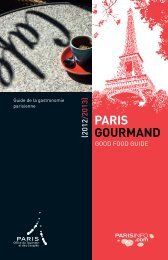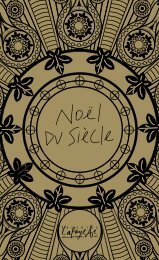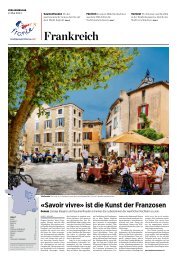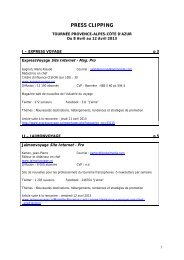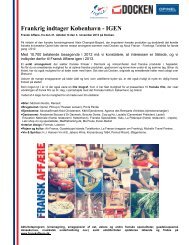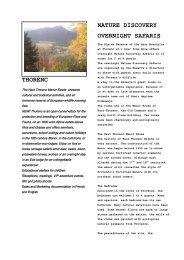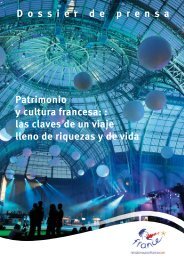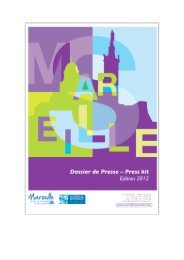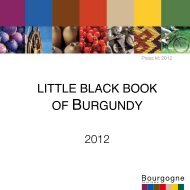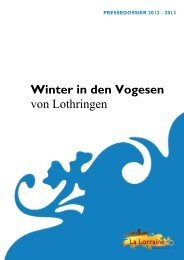Paris Opera Ballet La Source - Maison de la France
Paris Opera Ballet La Source - Maison de la France
Paris Opera Ballet La Source - Maison de la France
You also want an ePaper? Increase the reach of your titles
YUMPU automatically turns print PDFs into web optimized ePapers that Google loves.
Quartier Vil<strong>la</strong>rs<br />
Route <strong>de</strong> Montilly, 03000 Moulins<br />
Tél. + 33 (0) 4 70 20 76 20 / Fax + 33 (0) 4 70 34 23 04<br />
info@cncs.fr / www.cncs.fr<br />
Press re<strong>la</strong>tions<br />
Heymann, Renoult Associées<br />
Sarah Heymann – Eleonora Alzetta<br />
Tel +33 (0)1 44 61 76 76 / e.alzetta@heymann-renoult.com<br />
www.heymann-renoult.com (downloadable documents)<br />
<strong>La</strong> <strong>Source</strong><br />
<strong>Paris</strong> <strong>Opera</strong><br />
<strong>Ballet</strong><br />
Press book<br />
Exhibition<br />
From June 16<br />
to December 31,<br />
2012<br />
Press re<strong>la</strong>tions: Heymann, Renoult Associées / tel +33 (0)1 44 61 76 76 / e.alzetta@heymann-renoult.com / www.heymann-renoult.com<br />
Moulins Allier Auvergne / www.cncs.fr / 04 70 20 76 20
Contents<br />
Exhibition “Christian <strong>La</strong>croix, <strong>La</strong> <strong>Source</strong> and the <strong>Paris</strong> <strong>Opera</strong> <strong>Ballet</strong>” --------------------- p. 3<br />
Editorial by Brigitte Lefèvre, Director of Dance at the Opéra national <strong>de</strong> <strong>Paris</strong> -------------- p. 5<br />
The conception of the costumes, by Christian <strong>La</strong>croix, stage costume <strong>de</strong>signer --------------- p. 7<br />
A gui<strong>de</strong> through the exhibition, by Delphine Pinasa, Director of the c n c s ------------------ p. 8<br />
The story of the ballet <strong>La</strong> <strong>Source</strong> -------------------------------------------------- p. 11<br />
Curators and artistic direction ---------------------------------------------------- p. 13<br />
The Centre national du costume <strong>de</strong> scène et <strong>de</strong> <strong>la</strong> scénographie -------------------------- p. 14<br />
Around the exhibition ---------------------------------------------------------- p. 16<br />
Weekend package: Return to the sources --------------------------------------------- p. 17<br />
Practical information ----------------------------------------------------------- p. 18<br />
Graphics avai<strong>la</strong>ble to the press --------------------------------------------------- p. 19<br />
The c n c s would especially like to thank the Opéra national <strong>de</strong> <strong>Paris</strong><br />
for its essential contribution to this exhibition, which in itself is homage<br />
to the excellence of this great theatre. The Opéra national <strong>de</strong> <strong>Paris</strong> is,<br />
in addition, one of the founding institutions of the c n c s.<br />
<strong>La</strong> <strong>Source</strong><br />
<strong>Paris</strong> <strong>Opera</strong><br />
<strong>Ballet</strong><br />
Exhibition<br />
From June 16<br />
to December 31,<br />
2012<br />
The Centre national du costume <strong>de</strong> scène et <strong>de</strong> <strong>la</strong> scénographie continues its col<strong>la</strong>boration<br />
with Christian <strong>La</strong>croix, following him into the heart of the Opéra national <strong>de</strong> <strong>Paris</strong> where<br />
he created the costumes for the ballet <strong>La</strong> <strong>Source</strong>, in a choreography by Jean-Guil<strong>la</strong>ume<br />
Bart, Danseur Étoile. These sumptuous costumes embroi<strong>de</strong>red with Swarovski crystals were<br />
worn on stage by the <strong>Paris</strong> <strong>Opera</strong> <strong>Ballet</strong> at the Pa<strong>la</strong>is Garnier in the autumn of 2011 and are<br />
presented here in an exhibition organized by Christian <strong>La</strong>croix.<br />
Christian <strong>La</strong>croix, theater costume <strong>de</strong>signer<br />
Chrisitan <strong>La</strong>croix, great fashion <strong>de</strong>signer who has become a <strong>de</strong>signer of costumes for theater, opera<br />
and ballet, created the sumptuous costumes for the ballet <strong>La</strong> <strong>Source</strong>, given at the Opéra national<br />
<strong>de</strong> <strong>Paris</strong> in the autumn of 2011. This c<strong>la</strong>ssical ballet, which disappeared from the repertoire of the<br />
Opéra at the end of the 19th century, tells the story of the sacrifice of Naï<strong>la</strong>, spirit of the source, for<br />
the love of the hunter Djémil and his beautiful Nouredda.<br />
Jean-Guil<strong>la</strong>ume Bart, Danseur Étoile, trained at the School of Dance of the Opéra, had long had<br />
the project to bring this ballet back to life. Brigitte Lefèvre, Director of Dance at the Opéra national<br />
<strong>de</strong> <strong>Paris</strong> gave him the occasion to do so, uniting the dramaturge Clément Hervieu-Léger, costume<br />
<strong>de</strong>signer Christian <strong>La</strong>croix and scenographer Éric Ruf to accompany him in this adventure, and<br />
programming the ballet at the Pa<strong>la</strong>is Garnier.<br />
These costumes, of refined neo-c<strong>la</strong>ssical style for the fantasy roles, tinted with orientalism and shimmering<br />
colors for the folk characters, bear witness to the dream world of Christian <strong>La</strong>croix. He spoke<br />
about this during the preparation of the ballet in the costume workshops of the Opéra national <strong>de</strong><br />
<strong>Paris</strong>, saying, “I wanted to give the impression that these costumes, as well as the ballet, had come out of a long<br />
sleep with their freshness and memories intact, and, in addition, to have the rustic aspects contrast with the<br />
opulence of the broca<strong>de</strong>s, ornaments and jewels.”<br />
The ballet is a succession of nymphs in Romantic tutus ma<strong>de</strong> of Japanese organza (one of the lightest<br />
fabrics in the world); of odalisques draped in tunics and loose pants ma<strong>de</strong> from old saris; of Caucasian<br />
women as “Russian dolls”, in their ethnic dresses, and Caucasian men in coats inspired by<br />
traditional clothing but given new color with the palette of Christian <strong>La</strong>croix. Costumes, hairstyles<br />
and tiaras <strong>de</strong>corated with Swarovski crystals.<br />
Exhibiton curators: Christian <strong>La</strong>croix, stage costume <strong>de</strong>signer;<br />
Brigitte Lefèvre, Director of Dance at the Opéra national <strong>de</strong> <strong>Paris</strong><br />
and Delphine Pinasa, Director of the Centre national du costume <strong>de</strong> scène.<br />
Artistic direction: Christian <strong>La</strong>croix<br />
3
Exhibition / June 16 – December 31, 2012<br />
Bringing <strong>La</strong> <strong>Source</strong><br />
back to life<br />
“For Jean-Guil<strong>la</strong>ume Bart, it was necessary to reinvent <strong>La</strong> <strong>Source</strong>. When he came to speak to me<br />
about this in 1996 and showed me the libretto, the i<strong>de</strong>a of <strong>la</strong>unching into a reconstruction had already<br />
crossed his mind even though there was no trace left of the original choreography.<br />
A creation is always a history of osmosis between people. It was thus necessary to assemble an artistic<br />
team, a game which I adore p<strong>la</strong>ying, for this new ballet. I first invited Christian <strong>La</strong>croix to join us.<br />
We know each other well and he was immediately seduced by the spirit of the project and by Jean-<br />
Guil<strong>la</strong>ume’s involvement. He thought about the famous painting by Degas portraying Eugénie Fiocre,<br />
one of the original performers of <strong>La</strong> <strong>Source</strong>.<br />
The association of two artists from the Comédie-Française, another great home of stage arts also counted<br />
for a great <strong>de</strong>al in this adventure. Clément Hervieu-Léger accepted my invitation and contributed<br />
important dramaturgical support. Éric Ruf <strong>de</strong>signed the sets. He had constructed his own little<br />
workshop in his dressing room at the Comédie-Française, and I find it extraordinary that this actor,<br />
who makes us dream when he is on stage, has been able to <strong>de</strong>velop his other talent at the same time.<br />
<strong>La</strong> <strong>Source</strong> is a true artisanal creation in the noble sense of the term, bringing together people who are<br />
at the same time the inheritors of long traditions and who also share the same taste of discovery.<br />
<strong>La</strong> <strong>Source</strong> is a typical production of the Opéra <strong>de</strong> <strong>Paris</strong>, a link in the 300-year-old chain of the evolution<br />
of ballet. In the studio, the dancers shared a true complicity with Jean-Guil<strong>la</strong>ume, who is one of<br />
them. It was a conversation among them and with themselves, reuniting with the <strong>la</strong>rger history of the<br />
repertoire of the Opéra. It is also perhaps what can be called the French style, a style which should<br />
not be perceived as a closed i<strong>de</strong>ntity, but rather, as an open one. In a certain sense, this adventure of<br />
<strong>La</strong> <strong>Source</strong> leads us back more broadly to the meaning and p<strong>la</strong>ce of c<strong>la</strong>ssical ballet in today’s world.<br />
The first series of performances at the Pa<strong>la</strong>is Garnier came to an end, carried by the enthusiasm of the<br />
performers and the audience. How to prolong this sharing with the audience, to hold onto this production<br />
of <strong>La</strong> <strong>Source</strong> a little longer? Christian <strong>La</strong>croix, in his role as Honorary Presi<strong>de</strong>nt of the Centre<br />
national du costume <strong>de</strong> scène, gave us this occasion. It is for this reason that the Opéra national <strong>de</strong><br />
<strong>Paris</strong>, which along with the Comédie-Française and the Bibliothèque nationale <strong>de</strong> <strong>France</strong>, is one of<br />
the founding members of the c nc s, wanted to present the excellent work of its costume workshops<br />
here. The photographs by Anne Deniau and the film by François Roussillon complete the exhibition<br />
and bring their own testimony to the long progression of this adventure.<br />
The costumes by Christian <strong>La</strong>croix were essential partners for the dramaturgy and choreography<br />
of this production. They are part of a musical score, a symphony of colors, a tapestry of shimmering<br />
fabrics, and a subtle harmony of sha<strong>de</strong>s which in themselves evoke a world of theatrical illusion.<br />
Sharing their beauty and coming into contact with the work of the costume workshops, will lead the<br />
visitors to this exhibition on one of the roads of the creation of <strong>La</strong> <strong>Source</strong>.”<br />
Brigitte Lefèvre<br />
Director of Dance at the Opéra national <strong>de</strong> <strong>Paris</strong><br />
a Costume for Dadjé <strong>de</strong>signed by Christian <strong>La</strong>croix,<br />
Opéra national <strong>de</strong> <strong>Paris</strong>, 2011.<br />
© Anne Deniau.<br />
5
Exhibition / June 16 – December 31, 2012<br />
The conception<br />
of the costumes<br />
“I had never heard of <strong>La</strong> <strong>Source</strong> before Brigitte Lefèvre told me, several years ago, about the project to<br />
remount the ballet with choreography by Jean-Guil<strong>la</strong>ume Bart. They gave me the file on this forgotten<br />
ballet, which Martine Kahane (then Director of the Cultural Service at the <strong>Opera</strong>) had worked<br />
on, and this file, with its nymphs, elves and Caucasians, remained buried for several months more.<br />
But fortunately, the genie came back out of his <strong>la</strong>mp a year <strong>la</strong>ter. I listened while Clément Hervieu-<br />
Léger and Jean-Guil<strong>la</strong>ume Bart recounted their <strong>la</strong>test version of the adventures of Nouredda,<br />
Djémil and Dadjé in front of the extremely inspiring sketches and maquettes by Éric Ruf for his set<br />
project – a forest of thick cords and a velvet pa<strong>la</strong>ce – which brought to mind certain productions for<br />
ballets by Ro<strong>la</strong>nd Petit and the Marquis <strong>de</strong> Cuevas with sets <strong>de</strong>signed by Bérard, Chape<strong>la</strong>in-Midy,<br />
C<strong>la</strong>vé and Malclès, which I had seen in the 1950s. I thus worked on this production thinking about<br />
this very “<strong>Paris</strong> School” period (to my mind one of the summits of French taste) while p<strong>la</strong>cing it, of<br />
course, in our times. In addition, I <strong>de</strong>liberately refrained from looking at what remained of the original<br />
maquettes at the <strong>Paris</strong> <strong>Opera</strong> Library-Museum. Starting with these universes, I imagined three<br />
directions: a first proposition with a rather refined inspiration; a second, more neo-c<strong>la</strong>ssical, between<br />
history and folklore; and finally a third, more e<strong>la</strong>borate, baroque and ‘Russian’. In addition, I was<br />
very much at ease with the Swarovski ‘patronage’: this <strong>Source</strong> would shimmer, shine, dazzle. I also<br />
had the challenge of knowing nothing about the choreography which was still <strong>de</strong>veloping in Jean-<br />
Guil<strong>la</strong>ume’s mind, but, at the same time of being constantly attentive to his extremely precise directions.<br />
We finally <strong>de</strong>ci<strong>de</strong>d on the second solution, with timeless costumes reflecting an updated 19th<br />
century and containing authentic ethnic <strong>de</strong>tails. I had at my disposal the costume workshops at the<br />
Pa<strong>la</strong>is Garnier, a true couture house, and even more than that since we could work with i<strong>de</strong>as which<br />
do not exist in the world of fashion: illusion, fantasy and magic. Mirages of silk tulle and liquid brilliance<br />
for the stars; mists of changing colors like impressionist paintings for the elves; trompe-l’œil<br />
of nature and painting for the nymphs; mutation of immemorial patched tweeds with superimposed<br />
incrustations and patinas for the Caucasians; marvels of ancient saris rema<strong>de</strong> with a touch of<br />
Hollywood for the odalisques, etc.<br />
I wanted to give the impression that these costumes, as well as the ballet, had come out of a long sleep<br />
with their freshness and memories intact, and, in addition, with the rustic aspects contrasting with<br />
the opulence of the broca<strong>de</strong>s, ornaments and jewels. There followed several final and short weeks of<br />
work, to adjust Romantic hemlines, illuminated headdresses, diaphanous masses, etc., in re<strong>la</strong>tion to<br />
the progression of the rehearsals.<br />
Once the materials were chosen, cut and assembled, the accessories <strong>de</strong>ci<strong>de</strong>d upon and the colors finalized,<br />
I permitted myself to look at the 1866 maquettes and was surprised to find that I was very<br />
often close to the costumes of the creation. This reassured me – the music and the argument of the<br />
ballet continue to speak the same <strong>la</strong>nguage 145 years <strong>la</strong>ter.”<br />
Christian <strong>La</strong>croix, September, 2011<br />
a Christian <strong>La</strong>croix in the costume workshops<br />
at the Pa<strong>la</strong>is Garnier. © Anne Deniau.<br />
7
8<br />
A gui<strong>de</strong><br />
through the<br />
exhibition<br />
f<br />
By Delphine Pinasa<br />
Director of the Centre national<br />
du costume <strong>de</strong> scène<br />
This exhibition is an invitation to discover<br />
the costumes and accessories<br />
created for the ballet <strong>La</strong> <strong>Source</strong>, from<br />
their conception by Christian <strong>La</strong>croix<br />
to their creation by the costume work-<br />
a Maquette for Nouredda’s costume.<br />
© Christian <strong>La</strong>croix.<br />
shops at the Pa<strong>la</strong>is Garnier and finally<br />
to the staging of the ballet. The scenography<br />
of the exhibition p<strong>la</strong>ces the costumes<br />
in the context of their creation,<br />
recreating the costume workshops of the<br />
Pa<strong>la</strong>is Garnier in the exhibition spaces<br />
at the c nc s. Transported to the heart of<br />
the workshops, the visitor will discover<br />
these p<strong>la</strong>ces hid<strong>de</strong>n to the general public,<br />
where seamstresses and tailors work<br />
daily in the service of the splendor and<br />
beauty of theatrical productions.<br />
Elements presented<br />
in the disp<strong>la</strong>y cases<br />
The exhibition presents<br />
the costumes by role,<br />
following the or<strong>de</strong>r<br />
of appearance of the<br />
characters in the ballet.<br />
Soloists and groups of<br />
dancers are united in<br />
each disp<strong>la</strong>y case, where,<br />
Christian <strong>La</strong>croix, <strong>La</strong> <strong>Source</strong> and the <strong>Paris</strong> <strong>Opera</strong> <strong>Ballet</strong><br />
in addition to the costumes, the various<br />
stages of their construction can be seen<br />
through the sources of inspiration, technical<br />
research and artistic choices <strong>de</strong>ci<strong>de</strong>d<br />
upon as the production took form:<br />
the documents of inspiration of Christian<br />
<strong>La</strong>croix inclu<strong>de</strong> a rich iconography<br />
which he likes to assemble and which<br />
he sometimes gives to the heads of the<br />
workshops as mo<strong>de</strong>ls, but also authentic<br />
clothing on loan from the Quai Branly<br />
Museum as well as stage costumes from<br />
the c n c s collections which served as<br />
reference for certain shapes or <strong>de</strong>tails<br />
such as the nymphs’ tutus and the Caucasian<br />
men’s coats.<br />
costume maquettes by Christian <strong>La</strong>croix,<br />
who, as always, drawing with great<br />
generosity, offers a <strong>la</strong>rge number of propositions<br />
for each role. All the maquettes<br />
were presented to and discussed with<br />
the choreographer Jean-Guil<strong>la</strong>ume Bart<br />
and the costume workshops. They are<br />
the <strong>de</strong>parture point for the realization<br />
of the costumes.<br />
a Maquette for an elf man’s costume.<br />
© Christian <strong>La</strong>croix.<br />
The costume workshops at the<br />
Pa<strong>la</strong>is Garnier in a few words…<br />
For the ballet <strong>La</strong> <strong>Source</strong>, all the costumes<br />
were ma<strong>de</strong> in the costume workshops<br />
at the Pa<strong>la</strong>is Garnier where the<br />
work is allocated to different workshops:<br />
the “loose” workshop specializing<br />
in the making of women’s<br />
costumes; the tailoring workshop for<br />
the men’s costumes; the stitch workshop<br />
for stretch elements; the <strong>de</strong>coration<br />
workshop for jewelry, ornaments,<br />
dye and patina of the costumes; and<br />
the millinery workshop for the hats.<br />
The costumes are ma<strong>de</strong> according<br />
to the same techniques used for<br />
street clothing, but creativity, fantasy<br />
and stage sense are indispensa-<br />
a Left: maquette for an odalisque woman’s costume.<br />
© Christian <strong>La</strong>croix.<br />
a Costume for the Khan <strong>de</strong>signed by<br />
Christian <strong>La</strong>croix. © c n c s / Photo Pascal<br />
François.<br />
fabric samples, shimmering colored<br />
saris for the odalisques, ultra-light Japanese<br />
organza for Naï<strong>la</strong>; rich worked<br />
velvet for the Khan… dye tests for the<br />
costumes of Zaël and the elves; patterns<br />
and tracing cloths for Djémil; the coats<br />
for the Caucasian men; prototypes for<br />
the nymphs’ tiaras; the turbans for the<br />
odalisques, etc.<br />
work documents, sketches, measurement<br />
files and the inventories of the<br />
heads of the workshops… so many<br />
concrete witnesses to the exceptional<br />
know-how of the costume workshops<br />
of this prestigious theater which itself is<br />
honored in this exhibition.<br />
The elements on disp<strong>la</strong>y come from…<br />
• The Opéra national <strong>de</strong> <strong>Paris</strong>: costumes, dressmaking<br />
material, accessories and elements<br />
of the sets for the production <strong>La</strong> <strong>Source</strong>.<br />
• The Quai Branly Museum in <strong>Paris</strong>:<br />
loan of traditional Caucasian costumes.<br />
• The Galliera Museum, fashion museum<br />
of the city of <strong>Paris</strong>: loan of crinoline dresses<br />
• Swarovski: crystals<br />
• The c n c s : costumes from the collection<br />
a Headdresses for the Khan and<br />
an odalisque <strong>de</strong>corated with Swarovski<br />
crystals in the millinery workshop<br />
at the Pa<strong>la</strong>is Garnier. © Anne Deniau.<br />
ble complementary elements. Many<br />
of the operations are done by hand,<br />
requiring specific know-how and mastery<br />
of technical constraints.<br />
a Fabric choices for costumes by<br />
Christian <strong>La</strong>croix and Jean-Guil<strong>la</strong>ume<br />
Bart. ©Anne Deniau.<br />
Reports from the heart<br />
of the Pa<strong>la</strong>is Garnier<br />
The photographer Anne Deniau followed<br />
the e<strong>la</strong>boration of this production<br />
step by step during several<br />
months: the construction of the sets,<br />
the rehearsals, and most particu<strong>la</strong>rly<br />
the costume workshops, where<br />
she captured the complicity of the<br />
work between Christian <strong>La</strong>croix,<br />
Jean-Guil<strong>la</strong>ume Bart, the heads<br />
of the workshops and the dancers.<br />
This photographic report is a new<br />
and unique behind-the-scenes illustration<br />
of costume making at the<br />
Opéra <strong>de</strong> <strong>Paris</strong>.<br />
François Rousillons’s filmed interviews<br />
with Brigitte Lefèvre, Jean-<br />
Guil<strong>la</strong>ume Bart, Christian <strong>La</strong>croix,<br />
Éric Ruf and the dancers all bear witness<br />
to their involvement in the creation<br />
of the ballet. These interviews,<br />
as well as the photographic reports of<br />
the costume workshops and makeup<br />
room, plunge the public into the<br />
effervescent and fantastic universe<br />
of a theatre in full-swing preparations<br />
for a <strong>la</strong>rge production.<br />
Some exhibition<br />
highlights<br />
The choreography and the sets<br />
Since the costumes are created in<br />
close re<strong>la</strong>tionship with the i<strong>de</strong>as of the<br />
choreographer and with the intent of<br />
being worn in a theatrical space conceived<br />
by the set <strong>de</strong>signer, the visitor<br />
is invited to<br />
discover these<br />
two aspects here.<br />
Jean-Guil<strong>la</strong>ume<br />
Bart communicates<br />
his choreographic<br />
conception with some of<br />
his sketches and work<br />
documents which followed<br />
him through-<br />
Exhibition / June 16 – December 31, 2012<br />
out this creation. The set sketches<br />
and maquettes by Éric Ruf exp<strong>la</strong>in<br />
his scenographic project for the sets<br />
of this ballet.<br />
The grand exhibition space<br />
As a finale, the public is invited to “come<br />
on stage”, into the ballet during the<br />
scene where Zaël and the nymphs, suspen<strong>de</strong>d<br />
in full flight, have for sole décor<br />
a tree composed of thick cords.<br />
a The elves on stage.<br />
Pa<strong>la</strong>is Garnier, 2011. © Anne Deniau.<br />
The Swarovski crystals<br />
Swarovski and the Opéra national <strong>de</strong><br />
<strong>Paris</strong> became partners for the ballet <strong>La</strong><br />
<strong>Source</strong>. Swarovski, specialist in crystals,<br />
has had links with the Opéra national<br />
<strong>de</strong> <strong>Paris</strong> for several years. Brigitte<br />
Lefèvre suggested a closer col<strong>la</strong>boration<br />
for the creation of <strong>La</strong> <strong>Source</strong>. Christian<br />
<strong>La</strong>croix and Jean-Guil<strong>la</strong>ume Bart also<br />
agreed with this choice. The Swarovski<br />
collection was presented to Christian<br />
<strong>La</strong>croix who selected a <strong>la</strong>rge range of<br />
crystals in many colors and sizes to<br />
<strong>de</strong>corate the costumes.<br />
a Costume try-on session for an odalisque.<br />
© Anne Deniau.<br />
Ma<strong>de</strong>-to-measure mo<strong>de</strong>ls<br />
For the presentation of the costumes,<br />
the mo<strong>de</strong>ls were chosen for their capacity<br />
to reproduce dance movements.<br />
With the help of Jean-Guil<strong>la</strong>ume Bart,<br />
some of them were ma<strong>de</strong> to measure<br />
a Left: maquette for a Caucasian woman’s costume.<br />
© Christian <strong>La</strong>croix.<br />
a The Caucasian women on stage.<br />
Pa<strong>la</strong>is Garnier, 2011. © Anne Deniau.<br />
from casts of dancers’ bodies in typical<br />
positions from the choreography.<br />
These mo<strong>de</strong>ls were created by Daniel<br />
Cendron, an artist specializing in making<br />
fake bodies.<br />
Exhibition catalogue<br />
“Christian <strong>La</strong>croix, <strong>La</strong> <strong>Source</strong>,<br />
the <strong>Paris</strong> <strong>Opera</strong> <strong>Ballet</strong>”<br />
Co-publishers Actes Sud / c nc s<br />
Opening his sketch books for<br />
the ballet <strong>La</strong> <strong>Source</strong>, Christian<br />
<strong>La</strong>croix reveals the world behind<br />
the scenes of the creation of<br />
the costumes for this production<br />
performed by the <strong>Paris</strong> <strong>Opera</strong><br />
<strong>Ballet</strong> at the Pa<strong>la</strong>is Garnier<br />
in 2011.<br />
Un<strong>de</strong>r the direction of Delphine Pinasa<br />
With contributions by Christian <strong>La</strong>croix,<br />
Brigitte Lefèvre, Jean-Guil<strong>la</strong>ume Bart,<br />
Martine Kahane, Clément Hervieu-Léger<br />
and Éric Ruf.<br />
With the col<strong>la</strong>boration of<br />
Anne Deniau, photographer<br />
Graduate of Pont et Chaussées and<br />
the Central St. Martins School,<br />
Anne Deniau has worked<br />
regu<strong>la</strong>rly with the Opéra <strong>de</strong> <strong>Paris</strong><br />
since 2004. In the world of fashion<br />
she has worked with Alexan<strong>de</strong>r<br />
McQueen, John Galliano, Jean<br />
Paul Gaultier and others.<br />
She is currently preparing a book<br />
retracing 13 years spent at the<br />
si<strong>de</strong> of the <strong>de</strong>signer Alexan<strong>de</strong>r<br />
McQueen.<br />
Editions Actes Sud / 192 pages<br />
Indicative price: 35 €<br />
ISBN<br />
9782330009946.<br />
Press re<strong>la</strong>tions<br />
for the catalogue:<br />
Sophie Patey<br />
s.patey@actes-sud.fr<br />
Tel: +33 1 55 42 14 43<br />
9
The ballet<br />
<strong>La</strong> <strong>Source</strong><br />
f<br />
The original ballet<br />
<strong>La</strong> <strong>Source</strong>, a ballet in three acts and four<br />
tableaux, had its premier on November<br />
12, 1866 at the Théâtre <strong>de</strong> L’Opéra<br />
on rue Le Peletier. It was based on a<br />
libretto by Charles Nuitter and Arthur<br />
Saint-Léon, with choreography by<br />
Arthur Saint-Léon and music by<br />
Ludwig Minkus and Léo Delibes.<br />
It was performed 69 times and left the<br />
French repertoire in 1876 after having<br />
been programmed for the visit of the<br />
Shah of Persia and the inauguration of<br />
the Pa<strong>la</strong>is Garnier. Only a few traces<br />
remain of the original ballet: drawings<br />
and maquettes, news articles, stereoscope<br />
photographs, etc. Most were <strong>de</strong>stroyed<br />
during the fire at the Opéra on<br />
rue Le Peletier in October 1873.<br />
<strong>La</strong> <strong>Source</strong> was presented in different<br />
versions in many countries, notably<br />
in Russia, in Saint-Petersburg in 1869<br />
(Le Lys, choreography by Saint-Léon);<br />
in Italy, in 1876 (<strong>La</strong> Sorgente, choreography<br />
by Cesare Marzagora, based<br />
on that by Saint-Léon); in Austria, at<br />
the Viennese court (Naï<strong>la</strong> die Quellenfee,<br />
choreo graphy by Saint-Léon) in 1878.<br />
The <strong>la</strong>st production, by Violette Verdy<br />
and John Prinz for the New York City<br />
<strong>Ballet</strong>, dates from 1969.<br />
a Henri Alfred Darjou, poster for<br />
<strong>La</strong> <strong>Source</strong>, 1866. BNF-BMO.<br />
© Pascaline Noack.<br />
Exhibition / June 16 – December 31, 2012<br />
Argument of the ballet<br />
By Jean-Guil<strong>la</strong>ume Bart<br />
“On first reading, <strong>La</strong> <strong>Source</strong> is a typical<br />
19th century ballet where Romanticism<br />
and the orientalism then in vogue confront<br />
each other, a consequence of travel<br />
accounts by artists and scho<strong>la</strong>rs of the<br />
period. However, the most compelling<br />
element here is the re<strong>la</strong>tionship between<br />
man and nature. Two worlds are in cohabitation:<br />
the ‘earthly’ world represented<br />
by the Caucasians, the Khan<br />
and the odalisques, and the ‘invisible’<br />
world personified by Naï<strong>la</strong>, the water<br />
spirit; the elves and nymphs.<br />
In the first world, the characters are<br />
interested in power and riches. The<br />
other world, on the contrary, lives and<br />
evolves with the elements and seasons.<br />
It moves, and breathes imperceptibly, as<br />
do trees. The inhabitants live in unison<br />
and have no ambition. In Romanticism,<br />
nature and its different ‘faces’ have the<br />
power to change human states of mind.<br />
Heroes can come un<strong>de</strong>r the fatal spell<br />
of the Willis, but also un<strong>de</strong>r that of<br />
Ondine, pure and without malice, who<br />
returns to her aquatic state after trying<br />
to acquire a soul for the love of a man<br />
who will ultimately betray her. In <strong>La</strong><br />
<strong>Source</strong>, nature does not transform itself<br />
into another world which sucks the lifeblood<br />
from the humans. It remains a<br />
p<strong>la</strong>ce of symbiosis. But Naï<strong>la</strong> must sacrify<br />
herself, putting the future of her own<br />
world in peril in or<strong>de</strong>r for the human intentions<br />
to be realized. Can we not see<br />
here a metaphor for our times? Have<br />
we not abused a nature which has offered<br />
us so many benefits since the beginnings<br />
of time?”<br />
<strong>La</strong> <strong>Source</strong> in 2011<br />
By <strong>La</strong>ure Guilbert<br />
Editor of dance publications for Éditions<br />
at the Opéra national <strong>de</strong> <strong>Paris</strong><br />
“In 1997 Jean-Guil<strong>la</strong>ume Bart proposed<br />
a new adaptation of <strong>La</strong> <strong>Source</strong> to<br />
Brigitte Lefèvre and showed her the<br />
original libretto. Brigitte Lefèvre united<br />
a brilliant creative team around him<br />
– Christian <strong>La</strong>croix, Éric Ruf, Clément<br />
Hervieu-Léger and Dominique Bruguière,<br />
but the i<strong>de</strong>a was neither to ‘reconstruct’<br />
<strong>La</strong> <strong>Source</strong>, nor to follow the<br />
style of Saint-Léon, nor to work from<br />
original archives. The story is more intimate.<br />
It is the story of a child of this<br />
opera house who became performer,<br />
a Myriam Ould-Braham (Naï<strong>la</strong>) and<br />
Alexis Renaud (the Khan) on stage. Pa<strong>la</strong>is Garnier, 2011.<br />
© Anne Deniau.<br />
Étoile, then teacher and choreographer<br />
– a choreographer who cultivates with<br />
passion his attachment to the c<strong>la</strong>ssical<br />
universe. It is the story of a lover of the<br />
dance who has ma<strong>de</strong> his experience<br />
into a long odyssey to the near and far<br />
territories of his art. When he was very<br />
young, the perfume of <strong>La</strong> <strong>Source</strong> enticed<br />
him through the music of Delibes and<br />
Minkus, and, in fact is still with him<br />
today. Taking the original libretto as<br />
inspiration and infusing it with questions<br />
of our times, he has proposed a<br />
new creation, marked by the i<strong>de</strong>a of a<br />
voyage through the p<strong>la</strong>ces of memory<br />
represented by this ballet which had<br />
vanished from, and then reappeared<br />
in the repertoire.”<br />
Creation of the costumes and sets<br />
The costumes were ma<strong>de</strong> between January<br />
and October 2011 in the workshops<br />
of the Opéra national <strong>de</strong> <strong>Paris</strong> and<br />
the sets created by Eric Ruf, Societaire<br />
of the Comédie-Française, were ma<strong>de</strong><br />
starting at the end of 2010.<br />
The ballet on stage<br />
Rehearsals started on September 5,<br />
2011 in the Studio Lifar at the Pa<strong>la</strong>is<br />
Garnier. The first performance was<br />
on October 22 and was followed by<br />
18 additional performances at the Pa<strong>la</strong>is<br />
Garnier, with the <strong>la</strong>st on November<br />
12, 2011.<br />
Creation<br />
Orchestra of the Opéra national<br />
<strong>de</strong> <strong>Paris</strong><br />
Musical direction: Koen Kessels<br />
<strong>La</strong> <strong>Source</strong><br />
<strong>Ballet</strong> in two acts and three tableaux<br />
Libretto based on the orignial<br />
by Charles Nuitter and Arthur<br />
Saint-Léon<br />
Music: Léo Delibes, Ludwig Minkus,<br />
in a version by Marc-Olivier Dupin<br />
Choreography: Jean-Guil<strong>la</strong>ume Bart<br />
Sets: Éric Ruf<br />
Costumes: Christian <strong>La</strong>croix<br />
Lighting: Dominique Bruguière<br />
Dramaturgy: Clément Hervieu-<br />
Léger, Jean-Guil<strong>la</strong>ume Bart<br />
Brigitte Lefevre and Jean-Guil<strong>la</strong>ume Bart’s<br />
texts (Interviews by <strong>La</strong>ura Capelle and <strong>La</strong>ure<br />
Guilbert), are from the ballet <strong>La</strong> <strong>Source</strong>’s<br />
program, Opéra national <strong>de</strong> <strong>Paris</strong>, 2011-2012.<br />
11
Curators<br />
and Artistic<br />
direction of<br />
the exhibition<br />
f<br />
Christian <strong>La</strong>croix<br />
Artistic director<br />
He lives and works in <strong>Paris</strong> and Arles,<br />
where he was born. After studies in c<strong>la</strong>ssical<br />
literature and art history, he could<br />
not picture himself as artist, teacher or<br />
museum curator, and took the direction<br />
of fashion and costume, with Hermès<br />
and then Guy Paulin in <strong>Paris</strong>, Italy and<br />
Japan. He was artistic director at Jean<br />
Patou from 1982 to 1987 before Bernard<br />
Arnault foun<strong>de</strong>d the house of Christian<br />
<strong>La</strong>croix. At the same time, he <strong>de</strong>signed<br />
costumes for many theater, opera and<br />
ballet productions in <strong>France</strong> (Opéra<br />
national <strong>de</strong> <strong>Paris</strong>, Comédie-Française,<br />
Opéra-Comique, Festival d’Aix, Marseille)<br />
and abroad (<strong>la</strong> Monnaie in Brussels,<br />
the Metropolitan <strong>Opera</strong> in New<br />
York, the Vienna and Berlin <strong>Opera</strong>s).<br />
At the Opéra <strong>de</strong> <strong>Paris</strong> he <strong>de</strong>signed costumes<br />
for Cendrillon (P. Maxwell Davis,<br />
1986), Les Anges ternis (K. Armitage,<br />
1987), Jewels (G. Ba<strong>la</strong>nchine, 2000),<br />
Shéhéraza<strong>de</strong> (B. Li, 2001). Since 2000<br />
he has worked as a more industrial <strong>de</strong>signer<br />
(t g v, hotels, Gaumont cinemas)<br />
and as scenographer of his own work:<br />
Centre national du costume <strong>de</strong> scène;<br />
Fashion Museum and Decorative Arts<br />
Museum, <strong>Paris</strong>, in 2007; the Réattu Museum<br />
and Rencontres d’Arles in 2008<br />
– activities which have become prepon<strong>de</strong>rant<br />
since the recent end of his activities<br />
as fashion <strong>de</strong>signer. His projects in<br />
2012: Adrienne Lecouvreur at the Frankfurt<br />
<strong>Opera</strong> (Germany), Peer Gynt at the<br />
Comédie-Française (<strong>Paris</strong>), Salomé at<br />
the Saint Gall <strong>Opera</strong> (Switzer<strong>la</strong>nd), Le<br />
Bourgeois Gentilhomme at the Bouffes du<br />
Nord (<strong>Paris</strong>) and Madame Butterfly at the<br />
Hamburg <strong>Opera</strong> (Germany).<br />
Exhibition / June 16 – December 31, 2012<br />
Brigitte Lefèvre<br />
Curator<br />
Brigitte Lefèvre entered the School of<br />
Dance at the Opéra <strong>de</strong> <strong>Paris</strong> at the age<br />
of 8, and was hired as dancer in the ballet<br />
corps when she was 16. In 1970 she<br />
choreographed her first ballet, Mikrocosmos<br />
(with music by Bartok), for Jacques<br />
Garnier, Michaël Denard and herself.<br />
She left the Opéra in 1972 to found, with<br />
Jacques Garnier, the Theatre of Silence,<br />
based in <strong>La</strong> Rochelle from 1974 to 1985.<br />
She was hired as Chief Dance Inspector<br />
(Department of Music and Dance at<br />
the Ministry of Culture) in 1985, and<br />
in 1987 became General Inspector and<br />
the first Dance Delegate. In September,<br />
1992 she became General Administrator<br />
of the Opéra <strong>de</strong> <strong>Paris</strong>-Garnier, then<br />
in February, 1994, Adjunct-Director of<br />
Dance. On July 1, 1995 she was named<br />
Director of Dance at the Opéra national<br />
<strong>de</strong> <strong>Paris</strong>. Since her nomination, Brigitte<br />
Lefèvre has constructed a living repertoire<br />
which joins the past, present and<br />
future. While giving an important p<strong>la</strong>ce<br />
to tradition and maintaining the great<br />
c<strong>la</strong>ssical ballets – and in particu<strong>la</strong>r the<br />
productions by Rudolf Nureyev – she<br />
regu<strong>la</strong>rly programs choreographies<br />
which have marked the 20th century,<br />
and invites contemporary choreographers<br />
to remount ballets or to create<br />
new ones. Brigitte Lefèvre is Vice<br />
Presi<strong>de</strong>nt of the National Conservatory<br />
of Music and Dance of <strong>Paris</strong> and Administrator<br />
of the Théâtre national <strong>de</strong><br />
Chaillot. She is Comman<strong>de</strong>r in the National<br />
Or<strong>de</strong>r of Merit; Comman<strong>de</strong>r of<br />
Arts and Letters and Officer in the Legion<br />
of Honor.<br />
Eric Ruf<br />
Sets<br />
After studying at the École Nationale<br />
Supérieure <strong>de</strong>s Arts Appliqués et <strong>de</strong>s<br />
Métiers d’Arts Olivier <strong>de</strong> Serres (Applied<br />
Arts and Art Tra<strong>de</strong>s), at the École<br />
a Costume for a Caucasian woman <strong>de</strong>signed by Christian <strong>La</strong>croix.<br />
© c n c s / Photo Pascal François.<br />
Florent and at the National Conservatory<br />
of Dramatic Arts, he joined the<br />
Comédie-Française in 1993 and became<br />
the 498th Sociétaire in 1998.<br />
Parallel to his career as theater, cinema<br />
and television actor, he is a stage director<br />
and set <strong>de</strong>signer.<br />
As <strong>de</strong>signer-scenographer, he has created<br />
the sets for Cyrano <strong>de</strong> Bergerac (Edmond<br />
Rostand), Fantasio (Alfred <strong>de</strong> Musset),<br />
<strong>La</strong> vie du grand Don Quichotte et du gros<br />
Sancho Pança (Antonio Da Silva) and<br />
Loup (Marcel Aymé) at the Comédie-<br />
Française; for Mental <strong>de</strong> l’équipe (Émmanuel<br />
Bordieu) at the Théâtre du<br />
Rond-Point; for Fortunio (Messager) at<br />
the Opéra-Comique and for <strong>La</strong> Didone<br />
(Cavalli) at the Théâtre <strong>de</strong> Caen.<br />
He received the Gérard Philippe Prize<br />
from the city of <strong>Paris</strong> in 1999, is Chevalier<br />
in the Or<strong>de</strong>r of Arts and Letters,<br />
and received the Molière prize for set<br />
<strong>de</strong>sign and for supporting male role in<br />
Cyrano <strong>de</strong> Bergerac in 2007.<br />
Delphine Pinasa<br />
Curator<br />
Delphine Pinasa succee<strong>de</strong>d Martine<br />
Kahane as Director of the Centre national<br />
<strong>de</strong> costume <strong>de</strong> scène in August,<br />
2011. An art historian, specialist in stage<br />
costumes, and formerly Delegate Director<br />
of the CNCS, she worked for the Victoria<br />
and Albert Museum in London,<br />
the Ministry of Culture and Communication,<br />
and then at the Opéra national<br />
<strong>de</strong> <strong>Paris</strong> from 1993 to 2003, where she<br />
was first in charge of the costumes in<br />
the museum collection, and then head<br />
of the Costume Patrimony <strong>de</strong>partment<br />
beginning in 2001.<br />
Since 2005, with the exhibition Rouge at<br />
the <strong>Paris</strong> <strong>Opera</strong> Library-Museum, she<br />
has col<strong>la</strong>borated regu<strong>la</strong>rly with Christian<br />
<strong>La</strong>croix.<br />
Delphine Pinasa has curated many<br />
exhibitions in <strong>France</strong> and abroad and<br />
has published many works in re<strong>la</strong>tion<br />
to these exhibitions, including the history<br />
of the costume workshops at the<br />
Pa<strong>la</strong>is Garnier.<br />
13
14<br />
The Centre<br />
national<br />
du costume<br />
<strong>de</strong> scène<br />
et <strong>de</strong> <strong>la</strong><br />
scénographie<br />
f<br />
In brief<br />
The c n c s opened in July 2006 in<br />
Moulins in Auvergne and is the first<br />
conservation centre in <strong>France</strong> or abroad<br />
entirely <strong>de</strong>voted to material theatrical<br />
heritage. It has become a p<strong>la</strong>ce not to<br />
be missed for all lovers of theater arts<br />
and fashion. After appearing in their<br />
final productions at the Opéra national<br />
<strong>de</strong> <strong>Paris</strong>, the Comédie Française and<br />
numerous other theater companies, the<br />
a In the reserves at the c n c s.<br />
© c n c s / Photo Pascal François.<br />
© c n c s / Photo Jean-Marc Teissonnier (Ville <strong>de</strong> Moulins)<br />
Christian <strong>La</strong>croix, <strong>La</strong> <strong>Source</strong> and the <strong>Paris</strong> <strong>Opera</strong> <strong>Ballet</strong><br />
costumes arrive at the center for a second<br />
life during which they will never<br />
again be worn but will be conserved,<br />
studied and exhibited. The visitor to<br />
the c n c s is thus invited to plunge backstage<br />
into the heart of the greatest theaters<br />
and opera houses, where theatrical<br />
productions are born.<br />
a Costume’s preventive conservation.<br />
© c n c s / Photo Pascal François.<br />
The collections<br />
The c n c s conserves the most prestigious<br />
collections in the world, on <strong>de</strong>posit<br />
from its three founding institutions<br />
– the Bibliothèque national <strong>de</strong> <strong>France</strong>,<br />
the Comédie-Française and the Opéra<br />
national <strong>de</strong> <strong>Paris</strong> – as well as costumes<br />
donated to the c nc s by costume <strong>de</strong>signers,<br />
theaters, theater and dance companies,<br />
artists and their families.<br />
Today, more than 10,000 costumes and<br />
accessories are conserved in the ultramo<strong>de</strong>rn<br />
reserves of this 18th century<br />
cavalry barracks: the costumes worn<br />
by Maria Cal<strong>la</strong>s in Norma in 1964, Jean<br />
Marais’s armour in Britannicus in 1952,<br />
the tutus by Christian <strong>La</strong>croix for Les<br />
Anges ternis in 1987, the costumes by<br />
Philippe Découflé for the Olympic<br />
Games in Albertville in<br />
1992 and many more. The<br />
most beautiful theater costumes<br />
of all periods and styles<br />
come back to life at the c n c s<br />
through thematic exhibitions<br />
with scenography by some of<br />
the greatest people working in<br />
theater today. The most famous artists<br />
wore these prestigious costumes, and<br />
the most famous French <strong>de</strong>signers created<br />
them. Connoisseurs will recognize<br />
the <strong>la</strong>bels of Christian <strong>La</strong>croix,<br />
Thierry Mugler, Jean Paul Gaultier,<br />
Frank Sorbier and many others.<br />
Costume conservation<br />
When the costumes are not being exhibited<br />
they are conserved in the vast<br />
reserve area <strong>de</strong>signed by the architect<br />
Jean-Michel Wilmotte.<br />
With an area of 1,700 square meters, this<br />
building contains conservation areas on<br />
the ground floor and three floors of costume<br />
storage. The costumes, installed<br />
in “compactus” units, or rolling closets,<br />
are protected from light at a temperature<br />
of 18°C and with a hygrometric<br />
rate of 50%.<br />
An example of cultural<br />
<strong>de</strong>centralization<br />
Six years after its opening, the c nc s has<br />
won the wager of cultural <strong>de</strong>centralization<br />
and has surpassed its initial objectives<br />
concerning frequentation, with<br />
more than 80,000 visitors per year. It<br />
has an exceptional worldwi<strong>de</strong> reputation<br />
with museums, theaters, and dance<br />
and opera companies, and has created<br />
networks in education, research and artistic<br />
creation. The success of the c n c s<br />
exhibitions has gone far beyond the<br />
bor<strong>de</strong>rs of <strong>France</strong> thanks to their foreign<br />
travels. “Bêtes <strong>de</strong> scene” was presented<br />
in Madrid, “Rudolf Nureyev”<br />
in Saint-Petersburg, and “Christian<br />
<strong>La</strong>croix, costume <strong>de</strong>signer” has travelled<br />
around the world from Singapore<br />
to São Paulo, making the c n c s an international<br />
reference.<br />
Projects<br />
An exhibition going abroad<br />
The exhibition “Rudolf Noureev, <strong>la</strong><br />
trame d’une vie” (“Rudolf Nureyev,<br />
The Material of a Life”) which the c nc s<br />
opened to the public in November, 2009<br />
will be presented in the autumn of 2012<br />
at the De Young Museum in San Francisco.<br />
The De Young Museum wants<br />
to give more valor to its textile <strong>de</strong>partment<br />
and contacted the c n c s in or<strong>de</strong>r<br />
to benefit from its know-how and exhibition<br />
themes. This Nureyev exhibition<br />
already travelled to the Museum<br />
of Theatrical Art in Saint-Petersburg<br />
during the summer of 2010.<br />
Coming up…<br />
Exhibition “Les Habits du Pouvoir”<br />
from January to May, 2013<br />
From Olympian gods to sovereigns<br />
anointed by God; from saber to aspergillum;<br />
from the Republic to dictatorships…<br />
the exhibition will show<br />
how stage and cinema have treated the<br />
representation of power, from a simple<br />
evocation to the faithful reconstitution<br />
of famous portraits of rulers. Curators:<br />
Noëlle Giret and Martine Kahane /<br />
Scenography: A<strong>la</strong>in Batifoulier and<br />
Simon <strong>de</strong> Tovar<br />
An exhibition on the theme<br />
of the circus<br />
from June to December, 2013<br />
In partnership with the Bibliothèque<br />
nationale <strong>de</strong> <strong>France</strong> (Department of<br />
Theater Arts)<br />
The Board of Directors<br />
Chairman: Thierry Le Roy,<br />
Councillor of State<br />
Honorary Presi<strong>de</strong>nt: Christian <strong>La</strong>croix<br />
The c nc s<br />
Delphine Pinasa: Director<br />
Vincent Foray: Administrator<br />
Exhibition / June 16 – December 31, 2012<br />
Exhibitions presented<br />
at the Centre national<br />
du costume <strong>de</strong> scène<br />
since its opening<br />
L’envers du décor<br />
à <strong>la</strong> Comédie-<br />
Française et à<br />
l’Opéra <strong>de</strong> <strong>Paris</strong><br />
au x i x e siècle<br />
January 28 –<br />
May 20, 2012<br />
L’art du costume<br />
à <strong>la</strong> Comédie-<br />
Française<br />
June 11 –<br />
December 31, 2011<br />
Les Insolites,<br />
Formes et matières<br />
<strong>de</strong>s costumes <strong>de</strong><br />
scène January 29 –<br />
May 15, 2011<br />
Event of 2013<br />
Vestiaire <strong>de</strong> Divas<br />
June 5 –<br />
December 31, 2010<br />
Opéras russes,<br />
à l’aube <strong>de</strong>s <strong>Ballet</strong>s<br />
Russes<br />
December 12, 2009 –<br />
May 16, 2010<br />
Rudolf Noureev,<br />
<strong>la</strong> trame d’une vie<br />
May 8 –<br />
November 11, 2009<br />
Opening of the Rudolf Nureyev<br />
Memorial Space<br />
On his <strong>de</strong>ath on January 6, 1993, Rudolf<br />
Nureyev left an important collection<br />
of documents, objects, furniture,<br />
art objects and costumes from his private<br />
life and his activity as dancer and<br />
choreographer. In 2008 The Rudolf<br />
Nureyev Foundation ma<strong>de</strong> a gift of this<br />
collection to the c nc s to create a memorial<br />
space open to the public in the<br />
Quartier Vil<strong>la</strong>rs on a permanent basis.<br />
Au fil <strong>de</strong>s fleurs,<br />
scènes <strong>de</strong> jardins<br />
December 6, 2008 –<br />
April 19, 2009<br />
Costumes <strong>de</strong>s<br />
Mille et une Nuits<br />
May 17 –<br />
November 11, 2008<br />
Jean Paul Gaultier<br />
– Régine Chopinot :<br />
Le Défilé<br />
December 1, 2007 –<br />
April 27, 2008<br />
Christian <strong>La</strong>croix,<br />
costumier<br />
June 3 –<br />
November 11, 2007<br />
J’aime les<br />
m i l it a i re s !<br />
January 20 –<br />
May 13, 2007<br />
Théodore<br />
<strong>de</strong> Banville<br />
et le théâtre<br />
November 11 –<br />
January 7, 2007<br />
Bêtes <strong>de</strong> scène<br />
July 2 –<br />
November 5, 2006<br />
The scenographer Ezio Frigerio, who<br />
col<strong>la</strong>borated during many years with<br />
Rudolf Nureyev, became a close friend,<br />
and <strong>de</strong>signed his tomb at the cemetery<br />
in Sainte-Geneviève-<strong>de</strong>s-Bois, has been<br />
entrusted with the scenography of this<br />
permanent exhibition space.<br />
The project is inclu<strong>de</strong>d in the P<strong>la</strong>n<br />
Musées 2011-2013 of the Ministry of<br />
Culture and Communication. Opening<br />
is p<strong>la</strong>nned in 2013, the twentieth anniversary<br />
of Nureyev’s <strong>de</strong>ath, and will<br />
certainly help to confirm the popu<strong>la</strong>rity<br />
of the Center in years to come.<br />
15
16<br />
Around the<br />
Exhibition<br />
f<br />
Visits<br />
Individual Visits<br />
Daily: 10 am – 6 pm from June 16 to<br />
December 31; 10 am – 7 pm in July and<br />
August. Closed on December 25<br />
Gui<strong>de</strong>d tours<br />
Gui<strong>de</strong>d tours at 2.30 pm and 4 pm on<br />
Saturdays and Sundays and daily during<br />
school holidays.<br />
Discovery Visit<br />
Specially adapted for children ages 7<br />
and up, accompanied by at least one<br />
adult. 2.30 pm on Tuesdays and Saturdays<br />
during school holidays.<br />
a The faça<strong>de</strong> of the c n c s. © Marc Luczak.<br />
P<strong>la</strong>ying with the exhibition<br />
For children ages 7 and up, a treasure<br />
hunt through the exhibition, for a p<strong>la</strong>yful<br />
introduction to the museum: 2.30 –<br />
4 pm on Wednesdays.<br />
Workshop Visits<br />
For children ages 4 and up accompanied<br />
by at least one adult. An interactive<br />
discovery visit followed by an<br />
artistic workshop for the whole family,<br />
with a changing theme for each<br />
visit: Thursdays during school holidays,<br />
4 – 6 pm.<br />
Adult Group Visits<br />
With a lecturing gui<strong>de</strong>. Open to groups<br />
(minimum 10 participants). Reservation<br />
required. Visits avai<strong>la</strong>ble in foreign<br />
<strong>la</strong>nguages (English, Italian) by appointment<br />
and subject to avai<strong>la</strong>bility. Further<br />
information: groupes@cncs.fr<br />
Christian <strong>La</strong>croix, <strong>La</strong> <strong>Source</strong> and the <strong>Paris</strong> <strong>Opera</strong> <strong>Ballet</strong><br />
School and other groups<br />
Organized tours specially <strong>de</strong>signed to<br />
enable groups to actively discover the<br />
exhibitions. For school groups as well<br />
as others – adults and children – who<br />
wish to have specific support. Further<br />
information: pedagogie@cncs.fr<br />
Educational activities<br />
Workshops for adults, teenagers<br />
and children<br />
Organized and coordinated by professionals.<br />
To discover the great variety of<br />
artistic activities associated with the<br />
performing arts and the themes of the<br />
exhibitions: textile <strong>de</strong>coration, drawing,<br />
embroi<strong>de</strong>ry, painting, sculpture,<br />
music, col<strong>la</strong>ge, theater, dance…<br />
Individuals<br />
On Saturdays from September to<br />
De cember: weekly 2-hour drawing<br />
workshop. During school holidays on<br />
Tuesdays, Wednesdays and Fridays:<br />
day-long workshops to discover or perfect<br />
an artistic activity with a performing<br />
arts professional. For individuals or<br />
to share with family or friends.<br />
School and other specific groups<br />
An educational handbook is avai<strong>la</strong>ble<br />
on request or at www.cncs.fr. Teachers<br />
and coordinators are welcome to<br />
come to the c n c s to prepare a visit, or<br />
to create and organize a specific project.<br />
Visits and workshops can be adapted.<br />
Reservations and further information:<br />
pedagogie@cncs.fr<br />
a Drawing workshop. © c n c s / Pascal<br />
François.<br />
a The c n c s Documentation Center.<br />
© c n c s / Christine Pulvéry.<br />
The Documentation<br />
Center<br />
The Documentation Center is <strong>de</strong>dica<br />
ted to the general history of the<br />
performing arts and theatrical professions,<br />
stage costumes and fashion; a<br />
vast range of works re<strong>la</strong>ted to the temporary<br />
exhibitions is also avai<strong>la</strong>ble to<br />
the public. It is also a p<strong>la</strong>ce of pleasure<br />
and leisure for all theater, opera, ballet,<br />
costume and fashion lovers. A selection<br />
of books and vi<strong>de</strong>os on opera,<br />
ballet and theater is avai<strong>la</strong>ble. Open<br />
to the general public from Tuesday to<br />
Friday, 10 am – 12.30 pm and 2 pm –<br />
6p m. Further information:<br />
documentation@cncs.fr<br />
Films<br />
In the auditorium<br />
Continuous projection of documentary<br />
films. Films are selected in re<strong>la</strong>tion<br />
to the exhibition on view.<br />
Weekend<br />
package:<br />
Return to<br />
the <strong>Source</strong>s<br />
f<br />
From the costumes<br />
by Christian <strong>La</strong>croix<br />
to the calming waters<br />
of Vichy…<br />
To prolong the visit of the exhibition<br />
“Christian <strong>La</strong>croix, <strong>La</strong> <strong>Source</strong> and<br />
the <strong>Paris</strong> <strong>Opera</strong> <strong>Ballet</strong>”, the c n c s has<br />
joined with the Vichy Spa Hotel Les<br />
Célestins**** and with the Allier Tourist<br />
Board to create a weekend package:<br />
Return to the <strong>Source</strong>s.<br />
a Town Hall Square in Moulins. © dr<br />
Day One<br />
Dance and high fashion in Moulins<br />
around the exhibition “Christian<br />
<strong>La</strong>croix, <strong>La</strong> <strong>Source</strong>, and the <strong>Paris</strong><br />
<strong>Opera</strong> <strong>Ballet</strong>”<br />
a Arrival <strong>la</strong>te morning in Moulins,<br />
capital of the old Bourbon Duchy, city<br />
of Art and History<br />
a Lunch at the restaurant <strong>de</strong>corated<br />
by Christian <strong>La</strong>croix of the Centre<br />
national du costume <strong>de</strong> scène<br />
a Gui<strong>de</strong>d tour of the exhibition<br />
a Gourmet pause at the Grand Café<br />
in Moulins, one of the most beautiful<br />
Art Nouveau cafés in <strong>France</strong>,<br />
often frequented in her time by<br />
Coco Chanel<br />
a Departure for Vichy, queen<br />
of spa cities<br />
a Dinner at the N3 and night spent<br />
in Vichy.<br />
Exhibition / June 16 – December 31, 2012<br />
© Joël Damase<br />
Day Two<br />
Re<strong>la</strong>xation at the <strong>Source</strong>s in Vichy<br />
Day of discovery of Vichy and access to<br />
the Vichy Spa Les Célestins****. This<br />
exceptional spa covers an area of 7,500<br />
square meters and is <strong>de</strong>voted to beauty,<br />
health and well-being. On the program:<br />
sauna, hammam, thermal baths<br />
and cardio-training room… all the benefits<br />
of the waters of Vichy in a privileged<br />
environment!<br />
a Morning access to the Spa and the<br />
restorative treatments offered there<br />
a Lunch at the Célestins<br />
a Shopping (the shops are open<br />
on Sundays, many luxury brands),<br />
or time to visit the Art Deco<br />
architecture in Vichy, the Parc <strong>de</strong>s<br />
<strong>Source</strong>s and the Promena<strong>de</strong>s of the<br />
Allier <strong>La</strong>ke.<br />
a Departure <strong>la</strong>te afternoon<br />
P<strong>la</strong>ces to visit in the area:<br />
a The Allier Department contains<br />
more than 500 chateaux<br />
a Vichy Pastilles factory<br />
a Saint-Pourçain wine tastings<br />
a Vichy: its Art Deco architecture<br />
and its shops open on Sundays<br />
© Fabrice Vallon<br />
Vichy,<br />
queen of spa cities<br />
One of the most beautiful spa towns in<br />
Europe, Vichy has much to offer besi<strong>de</strong>s<br />
the proven virtues of it springs.<br />
Surroun<strong>de</strong>d by breathtaking countrysi<strong>de</strong>s,<br />
it also offer an impressive array of<br />
cultural, sports, leisure and sightseeing<br />
attractions… and all of this only half<br />
an hour by train from the c nc s.<br />
Rates<br />
328 € for two (164 € per person)<br />
Price based on two people in double<br />
room occupancy.<br />
Two days and one night.<br />
Offer valid from May 1 to<br />
November 1, 2012 except Sunday<br />
nights. No restrictions in July<br />
and August.<br />
Allier resa: tel +33 (0)4 70 46 81 60<br />
www.allier-tourisme.com<br />
© Fabrice Vallon<br />
June 19 and 20:<br />
Organization of a special trip for<br />
journalists in or<strong>de</strong>r to publicize this<br />
offer. Contact: Anne-<strong>La</strong>ure Bucelle,<br />
communications officer at the cn c s :<br />
albucelle@cncs.fr;<br />
tel: +33 (0)4 70 20 76 19<br />
17
18<br />
Practical<br />
information<br />
f<br />
Centre national du costume<br />
<strong>de</strong> scène et <strong>de</strong> <strong>la</strong> scénographie<br />
Quartier Vil<strong>la</strong>rs, Route <strong>de</strong> Montilly,<br />
03000 Moulins<br />
Tel: +33 (0)4 70 20 76 20<br />
Fax: +33 (0)4 70 34 23 04<br />
info@cncs.fr / www.cncs.fr<br />
Exhibition opening hours<br />
From June 16 to December 31, 2012<br />
The c nc s is open every day from<br />
10 am to 6 pm, and to 7 pm in July<br />
and August.<br />
Closed on December 25<br />
The c nc s will close at 4 pm on<br />
December 24 and 31.<br />
Entrance fees<br />
Full rate: 6 €<br />
Reduced rate: 3 € (for visitors aged<br />
12-25, the unemployed, RSA and<br />
other aid recipients, and groups<br />
of 10 and more)<br />
Free entry (except for groups) for<br />
children un<strong>de</strong>r 12 accompanied<br />
by an adult; disabled visitors<br />
and accompanying persons<br />
Supplement for gui<strong>de</strong>d visit:<br />
5 € per person<br />
Group fees<br />
(10 or more people)<br />
Unaccompanied visit: 3 € per person<br />
Gui<strong>de</strong>d visit: 60 € per group<br />
plus 3 € per person<br />
(maximum 30 people)<br />
Fees for school groups and others<br />
Unaccompanied visit: 3 € per person<br />
Gui<strong>de</strong>d visit: 80 € per group<br />
(maximum 25 people)<br />
Gui<strong>de</strong>d visit and workshop: 160 €<br />
per group (maximum 25 people)<br />
Workshop: 100 € per group<br />
(maximum 25 people)<br />
Annual membership<br />
Permanent access to the exhibitions,<br />
reduced fees for accompanying<br />
guests, reduced entrance fees to<br />
participating institutions and many<br />
other advantages.<br />
Full rate: 20 €<br />
Reduced rate: 10 €<br />
Christian <strong>La</strong>croix, <strong>La</strong> <strong>Source</strong> and the <strong>Paris</strong> <strong>Opera</strong> <strong>Ballet</strong><br />
Friends of the c n c s<br />
The Friends of the c n c s brings<br />
together amateurs of <strong>de</strong>corative arts,<br />
fashion, <strong>de</strong>sign and theater to insure<br />
that the museum is well-known<br />
in <strong>France</strong> and abroad.<br />
Contact: amis@cncs.fr<br />
Documentation Center<br />
Free entry. Open to the general<br />
public from Tuesday to Friday:<br />
10 am-12.30 pm and 2 pm-6 pm.<br />
Further information:<br />
documentation@cncs.fr<br />
Facilities for rent<br />
A 100-seat auditorium, restaurant<br />
with catering service and many<br />
meeting rooms are avai<strong>la</strong>ble<br />
for rental. Further information:<br />
Jean-Sebastien Judais<br />
jsjudais@cncs.fr<br />
Reservations<br />
General public and other<br />
group visits : groupes@cncs.fr<br />
Youth and educational activities:<br />
pedagogie@cncs.fr<br />
© c n c s<br />
The Café-Brasserie<br />
Welcoming, tailor-ma<strong>de</strong> service<br />
for lunch, cocktails and dinner or<br />
for morning and afternoon snacks.<br />
Wi-fi access. Sha<strong>de</strong>d terrace.<br />
Decoration by Christian <strong>La</strong>croix.<br />
Open from 11 am to 6 pm.<br />
Closed Monday but open daily<br />
during Zone A school holidays.<br />
For information and reservations:<br />
+33 (0)4 70 20 76 20<br />
lerestaurant@cncs.fr<br />
Couverture :<br />
Maquette for Naï<strong>la</strong>’s costume <strong>de</strong>signed by<br />
Christian <strong>La</strong>croix in the ballet <strong>La</strong> <strong>Source</strong>,<br />
Pa<strong>la</strong>is Garnier, 2011. © Christian <strong>La</strong>croix.<br />
Conception : Ata<strong>la</strong>nte-<strong>Paris</strong><br />
© c n c s / Photo Christine Pulvéry<br />
Bookshop-Boutique<br />
Books, objects, educational games,<br />
textile items, i<strong>de</strong>as for presents,<br />
dv d /cds, postcards and catalogues.<br />
Special children’s section. Free<br />
access during c nc s opening hours.<br />
Further information: www.cncs.fr<br />
Access<br />
On-site parking for cars<br />
and tour buses; easy access.<br />
Access map avai<strong>la</strong>ble on www.cncs.fr<br />
<strong>Paris</strong><br />
A71 Moulins<br />
Lyon<br />
Clermont-Ferrand<br />
Bor<strong>de</strong>aux<br />
Marseille<br />
Access for the disabled, wheelchair<br />
accessible areas; wheelchairs avai<strong>la</strong>ble<br />
at reception with advance reservation.<br />
Special advice is avai<strong>la</strong>ble to help p<strong>la</strong>n<br />
group visits for the disabled. Further<br />
information: pedagogie@cncs.fr<br />
Tourist information<br />
Moulins Tourist Office<br />
(Office <strong>de</strong> tourisme <strong>de</strong> Moulins)<br />
Tourism in Moulins and in the<br />
Bourbon country; discovery<br />
weekends including visits to the c n c s<br />
organized by the Moulins Tourist<br />
Office. www.pays-bourbon.com<br />
Tel: +33 (0)4 70 44 14 14<br />
Allier Tourist Board<br />
(Comité départemental du tourisme<br />
<strong>de</strong> l’Allier) www.allier-tourisme.com<br />
Tel : +33 (0)4 70 46 81 50<br />
Auvergne Region Tourist Board<br />
(Comité régional <strong>de</strong> développement<br />
touristique d’Auvergne)<br />
www.auvergne-tourisme.info<br />
Tel : +33 (0)4 73 29 49 46<br />
Vichy Spa Hôtel Les Célestins****<br />
111 bd <strong>de</strong>s États-Unis<br />
03200 Vichy<br />
www.vichy-spa-hotel.fr<br />
Tel: +33(0) 4 70 30 82 00<br />
Graphics avai<strong>la</strong>ble<br />
for the press<br />
f<br />
Costume try-on session in the<br />
presence of Brigitte Lefèvre<br />
and Christian <strong>La</strong>croix. Pa<strong>la</strong>is<br />
Garnier, 2011. © Anne Deniau.<br />
Fabric choice by Christian<br />
<strong>La</strong>croix for the costume<br />
of a Caucasian woman.<br />
© Anne Deniau.<br />
The nymphes, Pa<strong>la</strong>is Garnier, 2011.<br />
© Anne Deniau.<br />
Fabric samples of saris for the<br />
odalisques and headbands for the<br />
dancers. © Costume workshops<br />
of the Opéra national <strong>de</strong> <strong>Paris</strong>.<br />
Christian <strong>La</strong>croix and Valentine<br />
Co<strong>la</strong>sante, costume try-on for<br />
a nymph. © Anne Deniau.<br />
Maquette for a Caucasian<br />
woman’s costume.<br />
© Christian <strong>La</strong>croix.<br />
Costume try-on session for<br />
an odalisque in the presence<br />
of Jean-Guil<strong>la</strong>ume Bart. Pa<strong>la</strong>is<br />
Garnier, 2011. © Anne Deniau.<br />
The faça<strong>de</strong> of the c n c s.<br />
© Marc Luczak.<br />
Exhibition / June 16 – December 31, 2012<br />
Alexis Renaud (the Khan),<br />
Charline Gizendanner (Dadjé)<br />
and the odalisques. Pa<strong>la</strong>is Garnier,<br />
2011. © Anne Deniau.<br />
Isabelle Ciaravo<strong>la</strong> and<br />
Christian <strong>La</strong>croix, costume<br />
try-on for the role of<br />
Nouredda. © Anne Deniau.<br />
Alessio Carbone (Zaël).<br />
Pa<strong>la</strong>is Garnier, 2011.<br />
© Anne Deniau.<br />
Fabric samples for a Caucasian<br />
man’s costume. © Costume workshops<br />
of the Opéra national <strong>de</strong> <strong>Paris</strong>.<br />
Tutu for a nymph in<br />
the costume workshops<br />
at the Pa<strong>la</strong>is Garnier.<br />
© Anne Deniau.<br />
Myriam Ould-Braham (Naï<strong>la</strong>)<br />
and Alexis Renaud (the Khan).<br />
Pa<strong>la</strong>is Garnier, 2011.<br />
© Anne Deniau.<br />
The Caucasian’s women.<br />
Pa<strong>la</strong>is Garnier, 2011. © Anne Deniau.<br />
Fabric choices for the costumes by<br />
(from left to right) Xavier Ronze,<br />
Jean-Guil<strong>la</strong>ume Bart, Christian <strong>La</strong>croix<br />
and Michel Ronvaux. © Anne Deniau.<br />
Main staircase at the c n c s.<br />
© c n c s / Photo Christine Pulvéry.<br />
Downloadable documents at<br />
www.heymann-renoult.com<br />
Tutu for Naï<strong>la</strong>, Christian<br />
<strong>La</strong>croix. © c n c s / Photo<br />
Pascal François.<br />
Costumes for Dadjé and an<br />
odalisque in the costume<br />
workshops. Pa<strong>la</strong>is Garnier,<br />
2011. © Anne Deniau.<br />
Making of tiaras with Swarovski<br />
crystals for the nymphs, Christian<br />
<strong>La</strong>croix. © Anne Deniau.<br />
Dyeing of a Caucasian man’s costume.<br />
© Anne Deniau.<br />
In the reserves at the c n c s.<br />
© c n c s / Photo Pascal François.<br />
19




